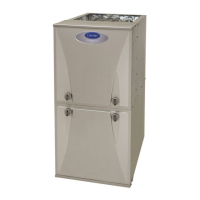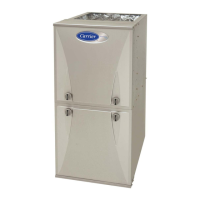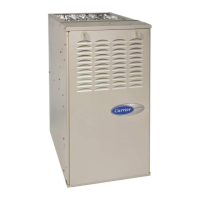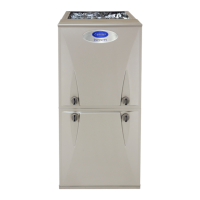PG96MSA: Installation, Start-up, Operating and Service and Maintenance Instructions
Manufacturer reserves the right to change, at any time, specifications and designs without notice and without obligations.
57
For proper operation and long term reliability, the Furnace input rate
must be within +/-2 percent of input rate on furnace rating plate, or as
adjusted for altitude.
The gas input rate on rating plate is for installations at altitudes up to
2000 ft. (609.6M).
In the USA., the input rating for altitudes above 2000 ft. (609.6M) must
be reduced by 2 percent for each 1000 ft. (304.8M) above sea level.
Refer to Table 25 or Table 26. The natural gas manifold pressures in
Table 23 adjust for BOTH altitude and natural gas heating value.
In Canada, the input rating must be reduced by 5 percent for altitudes of
2000 ft. (609.6M) to 4500 ft. (1371.6M) above sea level. The natural gas
manifold pressures in Table 25 adjust for BOTH altitude and natural gas
heating value.
Table 23 – Altitude Derate Multiplier for U.S.A.
To adjust manifold pressure to obtain the proper input rate, first,
determine if the furnace has the correct orifice installed. At higher
altitudes or different gas heat contents, it may be necessary to change the
factory orifice to a different orifice. Tables have been provided in the
furnace installation instructions to match the required orifice to the
manifold pressure to the heat content and specific gravity of the gas. To
do this:
1. Obtain average yearly gas heat value (at installed altitude) from
local gas supplier.
2. Obtain average yearly gas specific gravity from local gas supplier.
3. Find installation altitude in Table 25 or Table 26.
4. Find closest natural gas heat value and specific gravity in Table 25
or Table 26. Follow heat value and specific gravity lines to point of
intersection to find orifice size and manifold pressure settings for
proper operation.
5. Check and verify burner orifice size in furnace. NEVER ASSUME
ORIFICE SIZE. ALWAYS CHECK AND VERIFY.
6. Replace orifice with correct size, if required by Table 25 or
Table 26. Use only factory-supplied orifices. See EXAMPLE 1.
EXAMPLE 1: 0 - 2000 ft. (0 - 609.6M) altitude
Heating value = 1050 Btu/cu ft.
Specific gravity = 0.62
Therefore: Orifice No. 44
Manifold pressure: 3.4-in. w.c. (847 Pa)
(Furnace is shipped with No. 44 orifices. In this example, all main
burner orifices are the correct size and do not need to be changed to
obtain proper input rate.)
NOTE: To convert gas manifold Table pressures to Pascals, multiply
the in. w.c. value by 249.1 Pa/in. w.c. (1 in. w.c. = 249.1 Pa).
Check Inlet Gas Pressure
The inlet gas pressure must be checked with the furnace operating in
maximum heat. This is necessary to make sure the inlet gas pressure
does not fall below the minimum pressure of 4.5 in. w.c.
1. Make sure the gas supply is turned off to the furnace and at the
electric switch on the gas valve.
2. Loosen set screw on inlet tower pressure tap no more than one full
turn with a 3/32-in. hex wrench or remove the 1/8-in. NPT plug
from the inlet pressure tap on the gas valve.
3. Connect a manometer to the inlet pressure tap on gas valve.
4. Turn on furnace power supply.
5. Turn gas supply manual shutoff valve to ON position.
6. Turn furnace gas valve switch to ON position.
7. Jumper R and W thermostat connections at the furnace control
board.
8. When main burners ignite, confirm inlet gas pressure is between 4.5
in. w.c. (1125 Pa) and 13.6 in. w.c. (3388 Pa).
9. Remove jumper across thermostat connections to terminate call for
heat. Wait until the blower-OFF delay is completed.
10. Turn furnace gas valve electric switch to OFF position.
11. Turn gas supply manual shutoff valve to OFF position.
12. Turn off furnace power supply.
13. Remove manometer from the inlet pressure tap of the gas valve.
14. Tighten set screw on inlet tower pressure tap with 3/32-in. hex
wrench, or if 1/8-in. NPT plug was removed, apply pipe dope
sparingly to end of plug and re-install in the gas valve.
Adjust Manifold Pressure
NOTE: There are two manifold pressure tables in these instructions.
USE Table 26 FOR THE LOW CAPACITY 26,000 BTUh MODELS.
The low capacity model can be identified by the green label affixed to
the top of the gas valve. For all other models, see Table 25.
NOTICE
!
If orifice hole appears damaged or it is suspected to have been redrilled,
check orifice hole with a numbered drill bit of correct size. Never
redrill an orifice. A burr-free and squarely aligned orifice hole is
essential for proper flame characteristics.
NOTICE
!
The NATURAL GAS manifold pressure adjustments in Table 25 and
Table 26 compensate for BOTH altitude AND gas heating value. DO
NOT apply an additional de-rate factor to the pressures show in
Table 25 and Table 26. The values in this table are NOT referenced to
sea level; they are AS-MEASURED AT ALTITUDE.
The heating content of natural gas at altitude may already provide for a
reduction in capacity of the furnace. Be sure to obtain the expected
in-season gas heating value of the gas from the gas supplier BEFORE
making any adjustments for capacity or altitude. Refer to Table 25 and
Table 26. No adjustments to the furnace may be necessary at altitude
for certain gas heating values.
Refer to the instructions provided in the factory-specified LP/Propane
conversion kit for instructions for setting gas manifold pressures for
LP/Propane applications.
ALTITUDE PERCENT
OF
DERATE
DERATE
MULTIPLIER
FACTOR
*
*. Derate multiplier factors are based on midpoint altitude for altitude range.
NOTE: For Canadian altitudes of 2000 to 4500 ft. (610 to 1372 M), use
USA altitudes of 2001 to 2000 ft. (611 to 914 M) in Table 25 or
Table 26.
FT. M
0–2000 0-610 0 1.00
2001–3000 610-914 4-6 0.95
3001–4000 914-1219 6-8 0.93
4001–5000 1219-1524 8-10 0.91
5001–6000 1524-1829 10-12 0.89
6001–7000 1829-2134 12-14 0.87
7001–8000 2134-2438 14-16 0.85
8001–9000 2438-2743 16-18 0.83
9001–10,000 2743-3048 18-20 0.81
WARNING
!
FIRE HAZARD
Failure to follow this warning could result in personal injury, death,
and/or property damage.
Inlet pressure tap set screw must be tightened and 1/8-in. NPT pipe
plug must be installed to prevent gas leaks.

